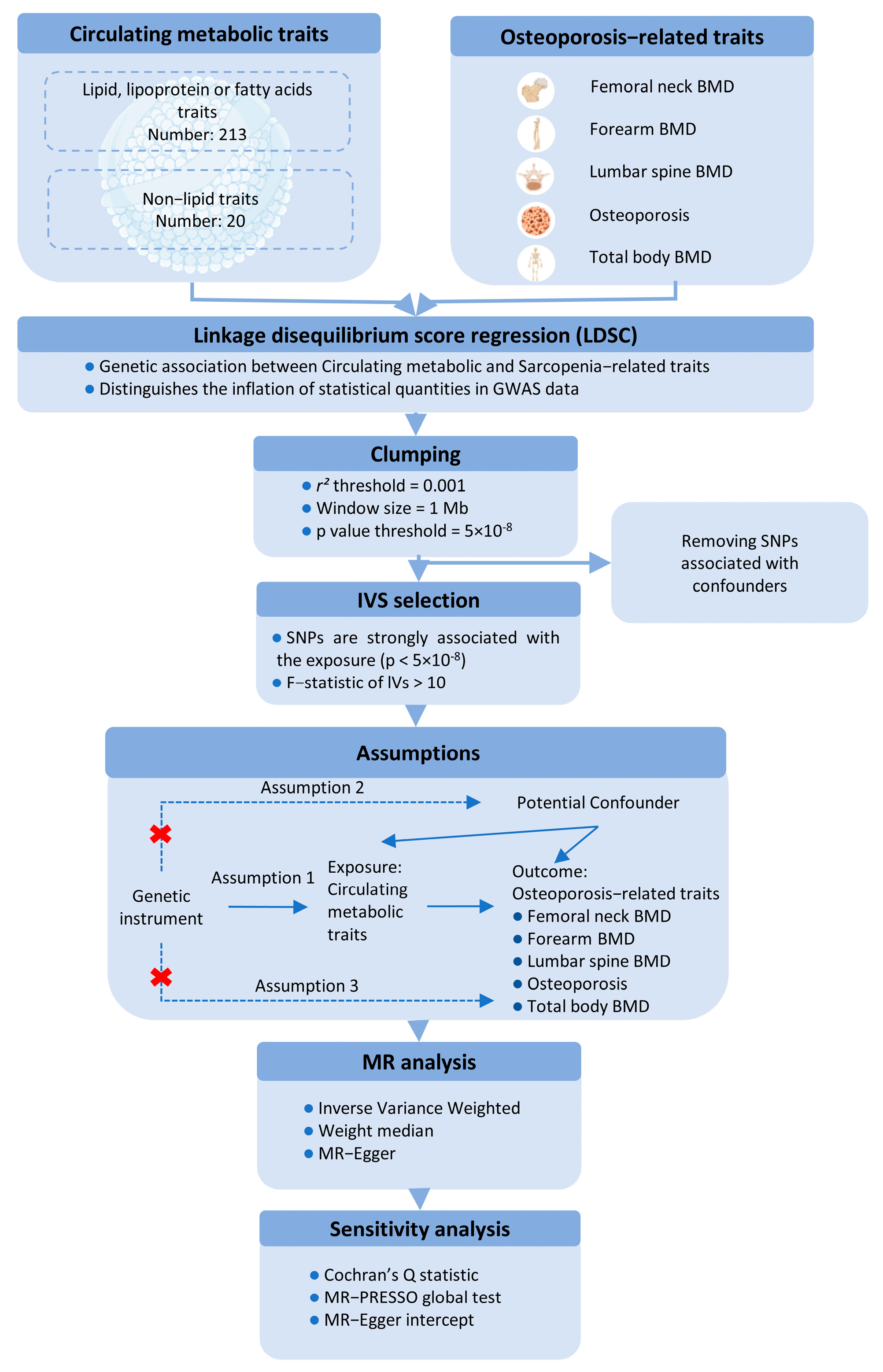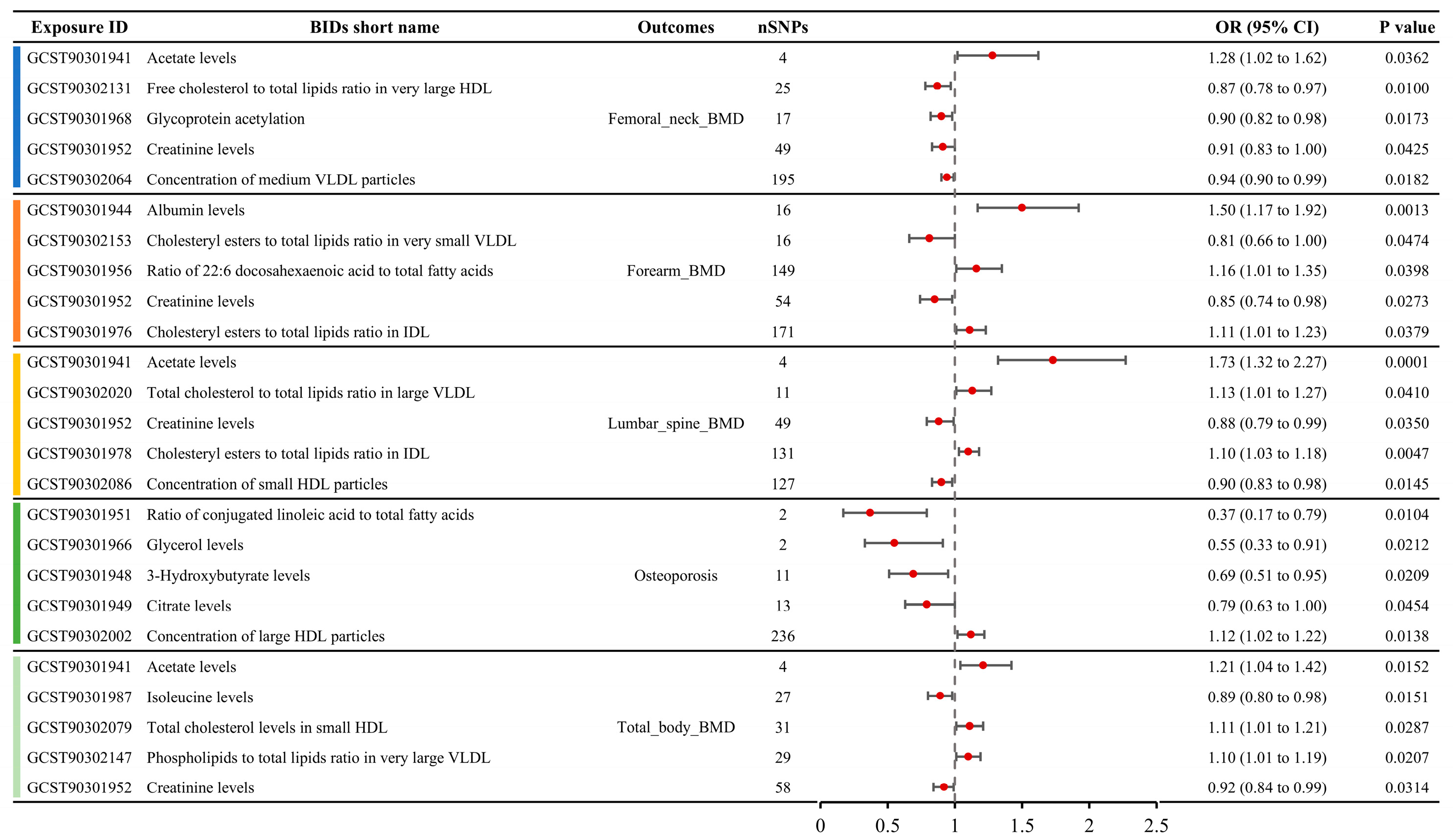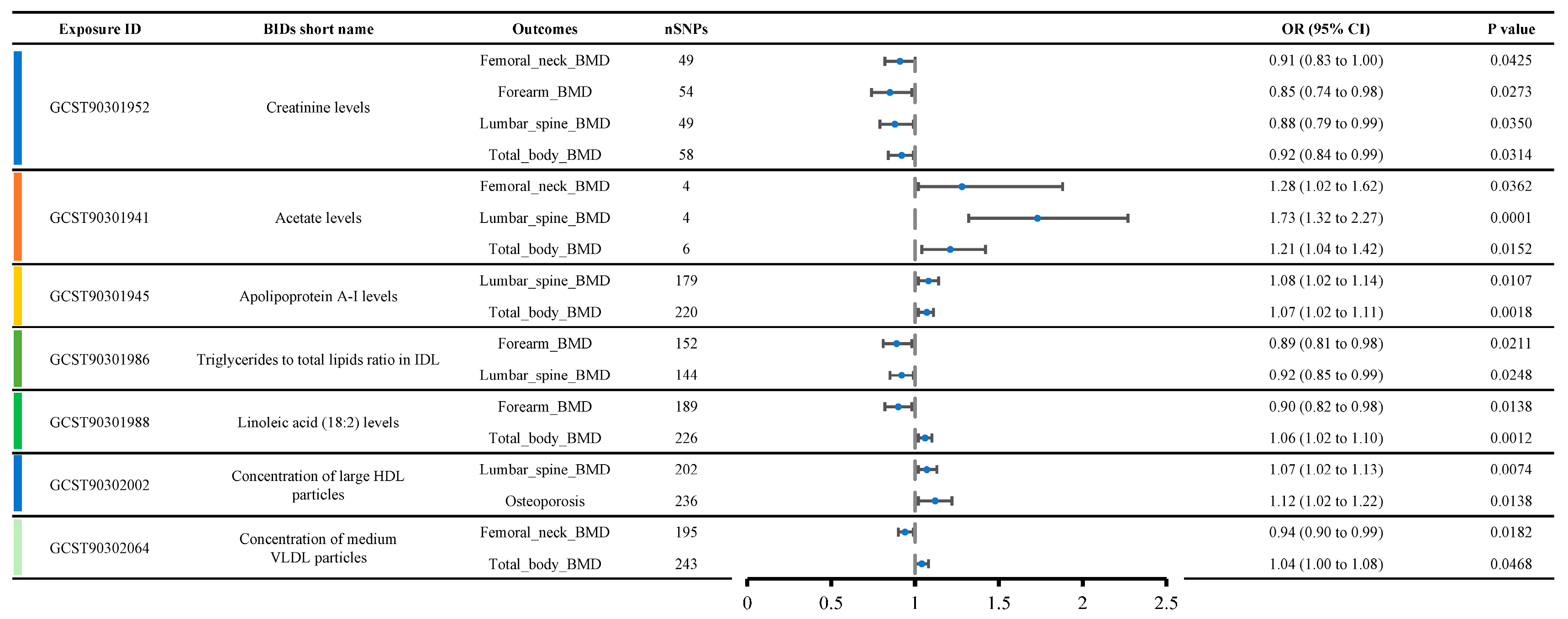Causal Relationship Between Blood Metabolites and Osteoporosis: A Two-Sample Mendelian Randomization and Genetic Correlation Analysis
Abstract
1. Introduction
2. Methods
2.1. Data Source
2.1.1. Circulating Metabolic Biomarkers GWAS Data Sources
2.1.2. OP and BMD Outcome Datasets
2.2. Statistics
2.2.1. Linkage Disequilibrium Score Regression Analysis
2.2.2. Two-Sample MR Analysis
3. Results
3.1. LDSC Results
3.2. Causal MR Associations Between Metabolites and BMD
3.3. Causal MR Associations Between Metabolites and OP
3.4. Metabolites with Multi-MR Effects in Osteoporosis-Related Traits
4. Discussion
5. Conclusions
Supplementary Materials
Author Contributions
Funding
Institutional Review Board Statement
Informed Consent Statement
Data Availability Statement
Acknowledgments
Conflicts of Interest
Abbreviations
| OP | Osteoporosis |
| MR | Mendelian randomization |
| GWAS | Genome-wide association study |
| LDCS | Linkage disequilibrium score regression |
| IVW | inverse-variance weighted |
| BMD | Bone mineral density |
| DXA | Dual-energy X-ray absorptiometry |
| IVs | Instrumental variables |
| GWAS | Genome-wide association study |
| NMR | Nuclear magnetic resonance |
| apoA-I | Apolipoproteins A-I |
| apoB | Apolipoproteins B |
| fnBMD | Femoral neck BMD |
| lsBMD | Lumbar spine BMD |
| foreBMD | Forearm BMD |
| toBMD | Total body BMD |
| OR | Odds ratio |
| λGC | Genome inflation factor |
| SNPs | Single nucleotide polymorphism |
| VLDL | Very low-density lipoprotein |
| IDL | Intermediate-density lipoprotein |
| HDL | High-density lipoprotein |
| LDL | low-density lipoprotein |
| HDL-C | HDL-Cholesterol |
References
- Aibar-Almazán, A.; Voltes-Martínez, A.; Castellote-Caballero, Y.; Afanador-Restrepo, D.F.; Carcelén-Fraile, M.D.; López-Ruiz, E. Current Status of the Diagnosis and Management of Osteoporosis. Int. J. Mol. Sci. 2022, 23, 9465. [Google Scholar] [CrossRef]
- Compston, J.E.; McClung, M.R.; Leslie, W.D. Osteoporosis. Lancet 2019, 393, 364–376. [Google Scholar] [CrossRef] [PubMed]
- Foessl, I.; Dimai, H.P.; Obermayer-Pietsch, B. Long-term and sequential treatment for osteoporosis. Nat. Rev. Endocrinol. 2023, 19, 520–533. [Google Scholar] [CrossRef] [PubMed]
- Salari, N.; Ghasemi, H.; Mohammadi, L.; Behzadi, M.H.; Rabieenia, E.; Shohaimi, S.; Mohammadi, M. The global prevalence of osteoporosis in the world: A comprehensive systematic review and meta-analysis. J. Orthop. Surg. Res. 2021, 16, 669. [Google Scholar] [CrossRef]
- Lewiecki, E.M.; Ortendahl, J.D.; Vanderpuye-Orgle, J.; Grauer, A.; Arellano, J.; Lemay, J.; Harmon, A.L.; Broder, M.S.; Singer, A.J. Healthcare Policy Changes in Osteoporosis Can Improve Outcomes and Reduce Costs in the United States. J. Bone Miner. Res. Plus 2019, 3, e10192. [Google Scholar] [CrossRef]
- Panahi, N.; Arjmand, B.; Ostovar, A.; Kouhestani, E.; Heshmat, R.; Soltani, A.; Larijani, B. Metabolomic biomarkers of low BMD: A systematic review. Osteoporos. Int. 2021, 32, 2407–2431. [Google Scholar] [CrossRef] [PubMed]
- Zhang, X.; Xu, H.; Li, G.H.; Long, M.T.; Cheung, C.L.; Vasan, R.S.; Hsu, Y.H.; Kiel, D.P.; Liu, C.T. Metabolomics Insights into Osteoporosis Through Association with Bone Mineral Density. J. Bone Min. Res. 2021, 36, 729–738. [Google Scholar] [CrossRef]
- Moayyeri, A.; Cheung, C.L.; Tan, K.C.; Morris, J.A.; Cerani, A.; Mohney, R.P.; Richards, J.B.; Hammond, C.; Spector, T.D.; Menni, C. Metabolomic Pathways to Osteoporosis in Middle-Aged Women: A Genome-Metabolome-Wide Mendelian Randomization Study. J. Bone Min. Res. 2018, 33, 643–650. [Google Scholar] [CrossRef]
- Liu, L.; Wen, Y.; Zhang, L.; Xu, P.; Liang, X.; Du, Y.; Li, P.; He, A.; Fan, Q.; Hao, J.; et al. Assessing the Associations of Blood Metabolites with Osteoporosis: A Mendelian Randomization Study. J. Clin. Endocrinol. Metab. 2018, 103, 1850–1855. [Google Scholar] [CrossRef]
- Wu, M.; Du, Y.; Zhang, C.; Li, Z.; Li, Q.; Qi, E.; Ruan, W.; Feng, S.; Zhou, H. Mendelian Randomization Study of Lipid Metabolites Reveals Causal Associations with Heel Bone Mineral Density. Nutrients 2023, 15, 4160. [Google Scholar] [CrossRef]
- Yu, X.H.; Cao, R.R.; Yang, Y.Q.; Zhang, L.; Lei, S.F.; Deng, F.Y. Systematic evaluation for the causal effects of blood metabolites on osteoporosis: Genetic risk score and Mendelian randomization. Front. Public Health 2022, 10, 905178. [Google Scholar] [CrossRef]
- Hemani, G.; Zheng, J.; Elsworth, B.; Wade, K.H.; Haberland, V.; Baird, D.; Laurin, C.; Burgess, S.; Bowden, J.; Langdon, R.; et al. The MR-Base platform supports systematic causal inference across the human phenome. eLife 2018, 7, e34408. [Google Scholar] [CrossRef]
- Yang, G.; Xie, W.; Li, B.; Zhao, G.; Li, J.; Xiao, W.; Li, Y. Casual associations between brain structure and sarcopenia: A large-scale genetic correlation and mendelian randomization study. Aging Cell 2024, 23, e14252. [Google Scholar] [CrossRef] [PubMed]
- Karjalainen, M.K.; Karthikeyan, S.; Oliver-Williams, C.; Sliz, E.; Allara, E.; Fung, W.T.; Surendran, P.; Zhang, W.; Jousilahti, P.; Kristiansson, K.; et al. Genome-wide characterization of circulating metabolic biomarkers. Nature 2024, 628, 130–138. [Google Scholar] [CrossRef] [PubMed]
- Aissani, B. Confounding by linkage disequilibrium. J. Hum. Genet. 2014, 59, 110–115. [Google Scholar] [CrossRef]
- Song, S.S.; Guo, Y.Y.; Yang, Y.H.; Fu, D.H. Advances in pathogenesis and therapeutic strategies for osteoporosis. Pharmacol. Ther. 2022, 237, 108168. [Google Scholar] [CrossRef]
- Lv, X.; Jiang, Y.; Yang, D.; Zhu, C.; Yuan, H.; Yuan, Z.; Suo, C.; Chen, X.; Xu, K. The role of metabolites under the influence of genes and lifestyles in bone density changes. Front. Nutr. 2022, 9, 934951. [Google Scholar] [CrossRef]
- Lau, K.T.; Krishnamoorthy, S.; Sing, C.W.; Cheung, C.L. Metabolomics of Osteoporosis in Humans: A Systematic Review. Curr. Osteoporos. Rep. 2023, 21, 278–288. [Google Scholar] [CrossRef] [PubMed]
- Yendt, E.R.; Cohanim, M.; Jarzylo, S.; Jones, G.; Rosenberg, G. Reduced creatinine clearance in primary osteoporosis in women. J. Bone Min. Res. 1993, 8, 1045–1052. [Google Scholar] [CrossRef]
- Huh, J.H.; Choi, S.I.; Lim, J.S.; Chung, C.H.; Shin, J.Y.; Lee, M.Y. Lower Serum Creatinine Is Associated with Low Bone Mineral Density in Subjects without Overt Nephropathy. PLoS ONE 2015, 10, e0133062. [Google Scholar] [CrossRef]
- Ishani, A.; Paudel, M.; Taylor, B.C.; Barrett-Connor, E.; Jamal, S.; Canales, M.; Steffes, M.; Fink, H.A.; Orwoll, E.; Cummings, S.R.; et al. Renal function and rate of hip bone loss in older men: The Osteoporotic Fractures in Men Study. Osteoporos. Int. 2008, 19, 1549–1556. [Google Scholar] [CrossRef] [PubMed]
- Hosmer, J.; McEwan, A.G.; Kappler, U. Bacterial acetate metabolism and its influence on human epithelia. Emerg. Top. Life Sci. 2024, 8, 1–13. [Google Scholar] [CrossRef]
- Zhang, Y.W.; Cao, M.M.; Li, Y.J.; Lu, P.P.; Dai, G.C.; Zhang, M.; Wang, H.; Rui, Y.F. Fecal microbiota transplantation ameliorates bone loss in mice with ovariectomy-induced osteoporosis via modulating gut microbiota and metabolic function. J. Orthop. Transl. 2022, 37, 46–60. [Google Scholar] [CrossRef] [PubMed]
- Lian, W.S.; Wu, R.W.; Lin, Y.H.; Chen, Y.S.; Jahr, H.; Wang, F.S. Tricarboxylic Acid Cycle Regulation of Metabolic Program, Redox System, and Epigenetic Remodeling for Bone Health and Disease. Antioxidants 2024, 13, 470. [Google Scholar] [CrossRef]
- Mao, J.; Yang, T.; Gu, Z.; Heird, W.C.; Finegold, M.J.; Lee, B.; Wakil, S.J. aP2-Cre-mediated inactivation of acetyl-CoA carboxylase 1 causes growth retardation and reduced lipid accumulation in adipose tissues. Proc. Natl. Acad. Sci. USA 2009, 106, 17576–17581. [Google Scholar] [CrossRef]
- Mangaraj, M.; Nanda, R.; Panda, S. Apolipoprotein A-I: A Molecule of Diverse Function. Indian J. Clin. Biochem. 2016, 31, 253–259. [Google Scholar] [CrossRef]
- Blair, H.C.; Kalyvioti, E.; Papachristou, N.I.; Tourkova, I.L.; Syggelos, S.A.; Deligianni, D.; Orkoula, M.G.; Kontoyannis, C.G.; Karavia, E.A.; Kypreos, K.E.; et al. Apolipoprotein A-1 regulates osteoblast and lipoblast precursor cells in mice. Lab. Investig. 2016, 96, 763–772. [Google Scholar] [CrossRef] [PubMed]
- Sun, X.; Wu, X. Association of apolipoprotein A1 with osteoporosis: A cross-sectional study. BMC Musculoskelet. Disord. 2023, 24, 157. [Google Scholar] [CrossRef]
- Ding, W.Y.; Protty, M.B.; Davies, I.G.; Lip, G.Y.H. Relationship between lipoproteins, thrombosis, and atrial fibrillation. Cardiovasc. Res. 2022, 118, 716–731. [Google Scholar] [CrossRef]
- Albitar, O.; D’Souza, C.M.; Adeghate, E.A. Effects of Lipoproteins on Metabolic Health. Nutrients 2024, 16, 2156. [Google Scholar] [CrossRef]
- Illingworth, D.R. Lipoprotein metabolism. Am. J. Kidney Dis. 1993, 22, 90–97. [Google Scholar] [CrossRef]
- Kan, B.; Zhao, Q.; Wang, L.; Xue, S.; Cai, H.; Yang, S. Association between lipid biomarkers and osteoporosis: A cross-sectional study. BMC Musculoskelet. Disord. 2021, 22, 759. [Google Scholar] [CrossRef]
- Lee, W.C.; Guntur, A.R.; Long, F.; Rosen, C.J. Energy Metabolism of the Osteoblast: Implications for Osteoporosis. Endocr. Rev. 2017, 38, 255–266. [Google Scholar] [CrossRef] [PubMed]
- Dragojevič, J.; Zupan, J.; Haring, G.; Herman, S.; Komadina, R.; Marc, J. Triglyceride metabolism in bone tissue is associated with osteoblast and osteoclast differentiation: A gene expression study. J. Bone Min. Metab. 2013, 31, 512–519. [Google Scholar] [CrossRef] [PubMed]
- Jiang, J.; Qiu, P.; Wang, Y.; Zhao, C.; Fan, S.; Lin, X. Association between serum high-density lipoprotein cholesterol and bone health in the general population: A large and multicenter study. Arch. Osteoporos. 2019, 14, 36. [Google Scholar] [CrossRef] [PubMed]
- Han, H.; Li, R.; Fu, D.; Zhou, H.; Zhan, Z.; Wu, Y.; Meng, B. Correlation between bone density, bone metabolism markers with lipid metabolism markers and body mass index. BMC Musculoskelet. Disord. 2024, 25, 162. [Google Scholar] [CrossRef]
- Xu, S.M.; Lu, K.; Yang, X.F.; Ye, Y.W.; Xu, M.Z.; Shi, Q.; Gong, Y.Q.; Li, C. Association of 25-hydroxyvitamin D levels with lipid profiles in osteoporosis patients: A retrospective cross-sectional study. J. Orthop. Surg. Res. 2023, 18, 597. [Google Scholar] [CrossRef]
- Niu, P.; Li, H.; Liu, D.; Zhang, Y.F.; Liu, Y.; Liang, C. Association Between HDL-C and Bone Mineral Density: An Cross-Sectional Analysis. Int. J. Gen. Med. 2021, 14, 8863–8872. [Google Scholar] [CrossRef]




Disclaimer/Publisher’s Note: The statements, opinions and data contained in all publications are solely those of the individual author(s) and contributor(s) and not of MDPI and/or the editor(s). MDPI and/or the editor(s) disclaim responsibility for any injury to people or property resulting from any ideas, methods, instructions or products referred to in the content. |
© 2025 by the authors. Licensee MDPI, Basel, Switzerland. This article is an open access article distributed under the terms and conditions of the Creative Commons Attribution (CC BY) license (https://creativecommons.org/licenses/by/4.0/).
Share and Cite
Liu, X.; Yang, G.; Li, Y.; Xiao, W.; Lu, B.; Wang, Y. Causal Relationship Between Blood Metabolites and Osteoporosis: A Two-Sample Mendelian Randomization and Genetic Correlation Analysis. Bioengineering 2025, 12, 435. https://doi.org/10.3390/bioengineering12050435
Liu X, Yang G, Li Y, Xiao W, Lu B, Wang Y. Causal Relationship Between Blood Metabolites and Osteoporosis: A Two-Sample Mendelian Randomization and Genetic Correlation Analysis. Bioengineering. 2025; 12(5):435. https://doi.org/10.3390/bioengineering12050435
Chicago/Turabian StyleLiu, Xu, Guang Yang, Yusheng Li, Wenfeng Xiao, Bangbao Lu, and Yaping Wang. 2025. "Causal Relationship Between Blood Metabolites and Osteoporosis: A Two-Sample Mendelian Randomization and Genetic Correlation Analysis" Bioengineering 12, no. 5: 435. https://doi.org/10.3390/bioengineering12050435
APA StyleLiu, X., Yang, G., Li, Y., Xiao, W., Lu, B., & Wang, Y. (2025). Causal Relationship Between Blood Metabolites and Osteoporosis: A Two-Sample Mendelian Randomization and Genetic Correlation Analysis. Bioengineering, 12(5), 435. https://doi.org/10.3390/bioengineering12050435







